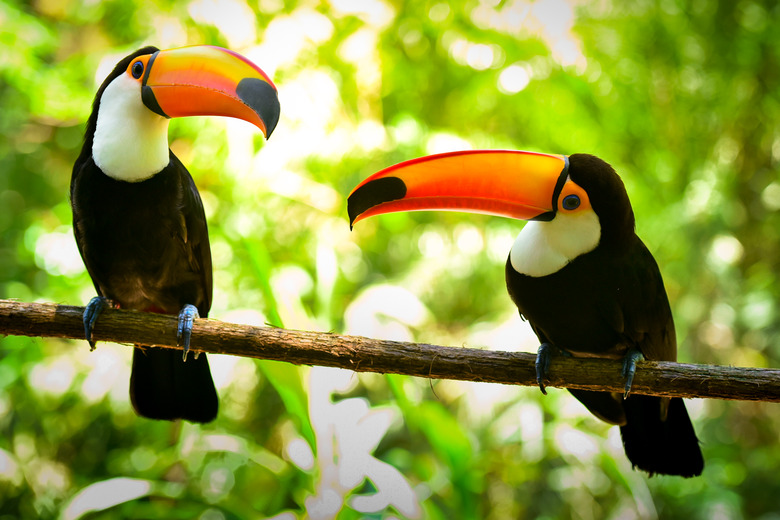Plants & Animals Found In Tropical Regions
The tropical regions of the world encompass the areas from the Tropic of Cancer (latitude 23 degrees 26 minutes North) in the Northern Hemisphere to the Tropic of Capricorn (latitude 23 degrees 26 minutes South) in the Southern Hemisphere. Bisected by the equator, these regions contain tremendous diversity in plant and animal species. Approximately 50 percent of known plant species are thought to originate in the tropics, giving it the highest plant diversity of any zone in the world. Over 14,000 known plant species reside within the Amazon region alone. Many familiar everyday products such as coffee and vanilla derive from tropical plants, and one mention of gaudy macaws and screeching monkeys can bring to mind the tropics. But they represent only a portion of the spectacular range of species in those regions.
TL;DR (Too Long; Didn't Read)
The tropical regions of the world house a tremendous amount of diverse plants and animals. While the tropics teem with vibrant animals such as parrots and monkeys, and popular food plants such as coffee and vanilla, many other species abound, and others have yet to be discovered.
Tropical Plant Food Resources
Tropical Plant Food
Resources
From everyday foods such as chocolate and sugar to exotic spices, fruits and vegetables, plants from tropical regions enhance people's diets. Beverages such as coffee, cocoa (derived from cacao), tea and kava derive from tropical plants. Coffee alone is considered one of the most valuable tropical exports in the world. Vanilla is derived from the seeds of a tropical orchid, and spices such as cinnamon, turmeric, allspice, ginger and cloves originated in the tropics. Fruits, vegetables, grains and nuts such as rice, taro, coconut, yam, avocado, pineapple, guava, mango, papaya, breadfruit and jackfruit also hail from tropical regions.
Ornamental Tropical Plants
Ornamental Tropical
Plants
Plants from tropical regions add beauty and charm inside and outside homes. Popular tropical plants for landscaping include:
- palms
- hibiscus
- amaryllis
- lily
- freesia
- gladiola
- bougainvillea
- bamboo
- banana
- camphor trees
- many others
Houseplants such as orchids, bromeliads and philodendrons also have a tropical origin.
Other Tropical Plant Uses
Other Tropical Plant
Uses
Tropical plants provide raw material for many products aside from food. Derivatives of tropical plants are used to make clothing and shelter. Valuable commercial timber resides within the region, though the challenge of deforestation looms large. Nearly 25 percent of today's medicines derive from tropical rain forest plants alone, and only a very small percentage of those plants have been studied for medicinal use. As more species are discovered, this number will likely increase.
Tropical Invertebrate Animals
Tropical Invertebrate
Animals
In tropical rain forests alone, animal diversity ranks the highest in the world. A staggering number of invertebrate animal species live in tropical regions. Some of the species types include butterflies, moths, centipedes and millipedes, scorpions, spiders, ants, crustaceans, snails, slugs, worms and beetles.
Vertebrate Tropical Animals
Vertebrate Tropical
Animals
While there are nowhere near as many vertebrate animals in tropical regions as there are invertebrates, vertebrate diversity remains high. Indeed, Costa Rica hosts howler monkeys and spider monkeys. Other tropical mammals include:
- sloths
- pangolins
- forest deer
- jaguars
- lemurs
- ocelots
In the Wet Tropics of Australia, some resident mammals include ringtail possums, quolls, tree-kangaroos and melomys. Enormous bird diversity within tropical regions abounds, with species such as hummingbirds, macaws, pigeons, birds-of-paradise, quetzals, eagles, toucans, cassowaries and owls all calling the region home. Many songbirds also winter in the tropics. But in addition to forest animals, many amphibious and aquatic animals thrive in the warm environment with its abundant water supply, such as frogs, salamanders, fish and snakes. River species include caimans, anacondas and river dolphins.
References
- Wet Tropics Management Authority: Introducing the Plants and Animals of the Wet Tropics
- Arbor Day Foundation: Animals and Plants of the Rain Forest
- University of Hawaii: Temperate and Tropical Food-Plants
- Texas A & M University: Creating the Tropical Look: Low-Care Tropicals for the Upper Gulf Coast of Texas
Cite This Article
MLA
Hermance, Dianne. "Plants & Animals Found In Tropical Regions" sciencing.com, https://www.sciencing.com/plants-animals-found-tropical-regions-6562132/. 22 November 2019.
APA
Hermance, Dianne. (2019, November 22). Plants & Animals Found In Tropical Regions. sciencing.com. Retrieved from https://www.sciencing.com/plants-animals-found-tropical-regions-6562132/
Chicago
Hermance, Dianne. Plants & Animals Found In Tropical Regions last modified March 24, 2022. https://www.sciencing.com/plants-animals-found-tropical-regions-6562132/
